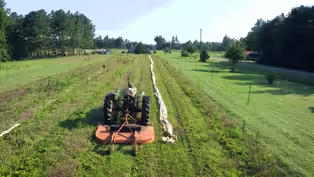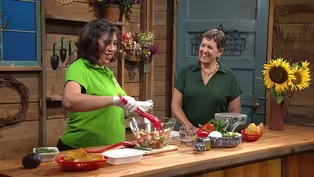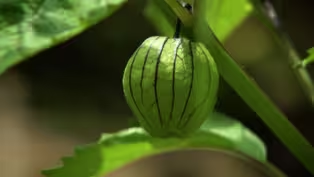Virginia Home Grown
Fifth-Generation Family Farm
Clip: Season 23 Episode 5 | 7m 56sVideo has Closed Captions
This family farm’s motto is, “know your farmer, know your food.”
Shana Williams tours Browntown Farms in Warfield with Herbert Brown junior and senior to learn about their commitment to connecting with the community and see how the farm has adapted to changing times and customer demands. Featured on VHG episode 2305; July 2023.
Problems playing video? | Closed Captioning Feedback
Problems playing video? | Closed Captioning Feedback
Virginia Home Grown is a local public television program presented by VPM
Virginia Home Grown
Fifth-Generation Family Farm
Clip: Season 23 Episode 5 | 7m 56sVideo has Closed Captions
Shana Williams tours Browntown Farms in Warfield with Herbert Brown junior and senior to learn about their commitment to connecting with the community and see how the farm has adapted to changing times and customer demands. Featured on VHG episode 2305; July 2023.
Problems playing video? | Closed Captioning Feedback
How to Watch Virginia Home Grown
Virginia Home Grown is available to stream on pbs.org and the free PBS App, available on iPhone, Apple TV, Android TV, Android smartphones, Amazon Fire TV, Amazon Fire Tablet, Roku, Samsung Smart TV, and Vizio.
Providing Support for PBS.org
Learn Moreabout PBS online sponsorship>>Working with my dad is always an adventure.
He has a lot of wisdom, he has a lot of knowledge that I've learned, and picked up from, and learned every day, so I'm very fortunate and blessed to still have my dad around to be able to be, you know, the leader and the legacy provider here on the farm.
Me, I'm more innovative and more focused on the marketing, and how we're gonna go to the next level, and really, it takes both of us to make this operation work, and that's been a real key to our success.
>>He's that foundation for you, and you're that future to allow y'all to branch out and grow.
>>Exactly, exactly, and I have a one-year-old son.
I'm hoping he would love to continue it on as well.
That would make me super happy for all the hard work that we've put down >>Definitely, definitely.
>>here on the farm.
>>It started when my grandparents bought this place in 1908.
It was in June, 1908, and they purchased 348 acres of land here for $1,000.
And I think the tax on that was, like, 56 cents or something like that, so.
It's been a long time ago.
I guess it's in my blood, and I'm just so happy a lot of people come by and buy their fresh vegetables, and they know what I put on it, you know?
It's just like, you know your farmer, you know your food, you know what you're eating.
It's a big difference in the food that you raise here and the food that come from Mexico, and I'm not saying it's bad, but they have to pick it half-green in order to get it here.
>>We're walking amongst some peppers, and what are you doing with some of these peppers?
>>Yeah, so these are bell peppers here.
We'll be utilizing these and dispersing 'em to the local markets.
We sell here off of the farm, and then, we have some wholesale markets in Richmond and in the Tri-Cities that we distribute to.
And we sell products all the way, anywhere traditionally from Raleigh, to Richmond, to D.C, or even Baltimore, Maryland.
The main thing that we produce and that we're known for is strawberries.
That's our main crop.
That's our spring crop.
And in the summertime, we kinda transition into grape tomatoes, peppers, and other summer crops, and then, in the fall, we get into kinda like the greens.
Collard greens, kales, and things of that nature.
>>Wonderful.
And I see that you have some habanero peppers over there.
>>Yeah, these are habanero peppers.
We love growing habanero peppers because they really produce well.
We normally get a pretty big yield off of habanero peppers.
And the great thing about these peppers is that we utilize these in our jam line.
So, when we grow strawberries, blueberries, blackberries, and all these crops, we create a value-added product, which is our strawberry and other fruit jams, and we utilize this for one of our jams, and a lot of people love that variety, that strawberry habanero variety to cook with.
>>And you've mentioned other crops as well.
So, you have your blueberries, you have your strawberries there for production, but do you also have tomatoes?
>>Yes, yes.
We grow tomatoes, we grow slicing tomatoes, and also, we do a lot of wholesale grape tomatoes.
So, we are able to ship those to our regional markets that's further away as well.
>>Okay, wonderful.
Now, please explain to me a little bit further of how are you going to really connect and expand this?
I understand that you are building a larger facility.
>>Yeah, so we just laid the foundation for our new multipurpose facility that will be constructed before the end of this year, and the goal of that facility is to allow us to move more produce, retail and wholesale.
It also will provide a place for customers to come to the farm, not only to purchase, but have a community space where we can teach people about farming, educate them, have different events and activities going on to get people acclimated with farm life.
>>And once again, know your farmer, know your food.
>>That's it.
>>Wonderful.
I see that you have a lot of open space here.
How do you plan on tapping into that space as you grow in the future?
>>Yeah, so a lot of open space we have here at the farm, it can be used to expand our operation.
So, as we grow along with our demand and our customer base, we hoping to open more land up so we can grow more produce to supply more retail customers and more wholesale customers.
Also, some of the open space that we have here on the farm, we hoping to utilize it for agritourism, so we can bring people to the farm for different activities, like camping or farm-to-table dinners, and things of that nature.
So, our goal really is to use every inch of this farm to make it useful and accessible to the public.
>>You have a beautiful facility here.
What does it mean to you to be, to have a century-old farm?
>>Oh wow, that's an amazing question.
You know, to be a Black century farm, it's very rare.
Black farmers make up 2% of the total farming population in the U.S, so for me to be in this space is very special to me, and that's one of the reasons why I invest all of my time and energy, and I'm all about all things agriculture, because I know that I'm making a difference, and I'm creating something for the future generation to see, because this very well could be lost.
I mean, it's not a lot of Black farmers, and we need the next generation to come in and continue to farm.
So, for me, it's all about legacy, but it's more importantly about showing everyone else what's possible and Black farmers do exist, because when I travel out, and I go out and I tell people I'm a farmer, and they say, "Well, you don't look like a farmer," and I ask them, I say, "Well, what is a farmer supposed to look like?"
So, it's all about changing the narrative, and giving people a realistic vision of what we're doing here in Warfield, Virginia.
So, it's very important to me to carry on that legacy and that Black farmer history, 'cause Black farmers have a lot of rich history here in Virginia and throughout the nation, so it's up to us who's still on the farm to keep it going and spread the word that we do exist.
>>As the future of this farm, as the leader here, and you've shared some of the innovative ideas, what additional things are you going to do to continue to grow this farm?
>>Being innovative in agriculture now, on this farm is critical.
I wanna grow that value-added product line.
I wanna bring people to the farm so they can have that experience.
You know, one of the examples that I use when I see kids, and I hold up a jar of jam and I say, "Hey, what is this," and they say, they're reading.
They say, "This is jam," and I said, "This is agriculture, this is farming."
And I also wanna let everybody know that you don't have to be a farmer to be a part of agriculture.
Most of the jobs and the value of that food-dollar comes from non or off-farm businesses.
So, you can be a part of agriculture in a variety of ways.
You can go to school, you can work in an industry that involves agriculture, and work that career every day of your life, and you don't necessarily have to be actually on the farm.
And we need, as farmers, we need that form of support of businesses in the future generation of leaders to lead these businesses and lead these organizations, so as farmers, we can have all of the resources that we need.
So, I definitely encourage anybody who looking to get into agriculture, if you wanna be a farmer, great.
I love it.
But if farming is not for you, I would love for everybody to look at a option, how you can support agriculture by choosing a career in the agriculture industry.
>>Yeah, and actually, like you say, you can have a business and connect with farmers such as yourself, and continue to grow it.
>>That's it.
>>But you just mentioned a lot of the hard work and stuff that this actually has to do, but it evidently fulfills you.
So, tell me some of the things that are connected to all the hard work that you put in and what it means to you.
>>Yeah.
So, you know, agriculture is a culture itself, and years ago, I fell in love with the culture.
And in short, agriculture is food, shelter, and clothing, and as we have people come here to the farm, that's how I explain agriculture in short.
Food, clothing, and shelter.
And as we move forward, that's what we wanna do here at Browntown Farms.
We wanna expose people to what agriculture is all about so they can understand, they can come here and just get a dose of nature, and just be a part of the land, so they can understand exactly where their food comes from.
>>I love it, and I wish the Browntown Farm much success.
Video has Closed Captions
Clip: S23 Ep5 | 26m 46s | Fresh food is one of the garden's best rewards! (26m 46s)
Video has Closed Captions
Clip: S23 Ep5 | 6m 53s | Learn how to make your own jam (6m 53s)
Video has Closed Captions
Clip: S23 Ep5 | 8m 38s | Traditional Mexican recipes from La Milpa restaurant (8m 38s)
Video has Closed Captions
Clip: S23 Ep5 | 3m 26s | Maximize garden space by growing vertically on a fence (3m 26s)
Video has Closed Captions
Clip: S23 Ep5 | 8m 23s | Fresh ingredients from farm-to-kitchen at La Milpa restaurant (8m 23s)
Video has Closed Captions
Clip: S23 Ep5 | 3m 7s | Learn about uses for sesame leaves in traditional Korean cuisine (3m 7s)
Providing Support for PBS.org
Learn Moreabout PBS online sponsorship

- Home and How To

Hit the road in a classic car for a tour through Great Britain with two antiques experts.












Support for PBS provided by:
Virginia Home Grown is a local public television program presented by VPM






